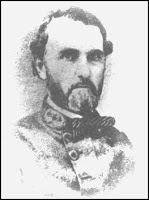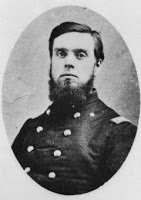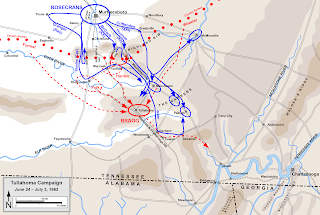Two important Middle Tennessee battles were fought between Braxton Bragg's and William Rosecrans's armies on this Thursday in 1863, the second day of fighting in the Tullahoma Campaign. These key battles were fought in a range of foothills, almost mountainous in height, through which passed roads connecting Murfreesboro to Tullahoma. The main action will take place at Hoover's and Liberty Gaps. It will be through these gaps in the Cumberland Rim that Rosecrans's will strike General William Hardee's Corps, the right wing of the Army of Tennessee.
Early in the morning, Union Gen. Rosecrans began moving his infantry, commanded by Maj. Gen. Thomas L. Crittenden, south through the community of Pocahontas1 to attack Manchester from the north. The plan called for Crittenden to swing his corps wide around Bragg's flank near the Nashville & Chattanooga Railroad bridge over the Elk River. Gen. George Thomas was ordered to support Crittenden by moving his corps along the Manchester Pike and attracting all the attention he could at Hoover's Gap. Once Crittenden was behind the Confederate flank, Thomas was to shift to his left and join Crittenden.
Meanwhile, Brig. Gen. Alexander McCook was to provide a diversion for Crittenden's movement by attacking Liberty Gap with his division. As soon as Thomas left Hoover's Gap, McCook was to follow him out of Liberty Gap. To complete the move, Maj. Gen. Gordon Granger would lead the Reserve Corps down the Shelbyville Pike, toward Confederate Gen. Leonidas Polk's Corps, to attract additional attention toward the area of Maj. Gen. David S. Stanley's all-day cavalry skirmish around Unionville. Granger was to build campfires to give the impression of a large infantry advance in that direction. His ruse succeeded in holding Polk at Shelbyville for 2 days.
About noon, Brig. Gen. Robert Mitchell was ordered to attack the Confederates at Middleton with his cavalry division and then to await support. Accordingly, Mitchell pulled back to Eagleville and turned east to attack Middleton. However, Mitchell came under attack by Confederates posted about a mile west of town, including 3 Confederate cavalry units, which forced him to fall back. Col. Robert Minty's cavalry brigade joined Mitchell's division, and the Federals pulled back northeast to Christiana on the main road from Murfreesboro to Shelbyville. So much for the Federal cavalry action on this date.
Earlier that morning, Gen. Crittenden's infantry corps was making the main advance, moving from Cripple Creek and Readyville, toward Bradyville. At Gilly's Hill his leading division, Brig. Gen. John Palmer's, fought a skirmish with the Confederates. At this point Crittenden's infantry advance became bogged down in the mud, and Rosecran's plan to take Manchester had to be modified.
McCook directed his corps down the the Liberty Pike towards Liberty Gap, where an important 3-day battle would be fought. Liberty Gap was one of several gaps in the Highland Rim, and it was of strategic importance to Rosecrans for either defeating Bragg or driving him from Middle Tennessee. A road through the gap, Liberty Pike, connected the railroad communities of Christiana and Bell Buckle, and extended through the Liberty Gap.
As McCook's troops neared the gap, reaching a hill known as "The Knob," Confederate soldiers opened fire. From there until they reached the village of Christiana, the Union infantry had to contend with Confederate cavalry and artillery. A portion of Crittenden's Corps, R.W. Johnson's Division, passed through Christiana and on towards Liberty Gap. Waiting for them was part of a division of Confederate infantry, some of the most tenacious fighters in the Army of Tennessee, commanded by its best combat leader, Maj. Gen. Patrick R. Cleburne. In Cleburne's division, was Great Grandfather Oakes's regiment, the 32nd Mississippi Infantry, although at this moment it was on duty at nearby Bell Buckle Gap, 3.5 miles south.
Two Arkansas regiments of Brig. Gen. St. John R. Liddell’s Brigade of Cleburne's Division defended Liberty Gap from its northern slopes. The Arkansaians briefly halted Johnson's advance. His division pressed through the gap taking positions around the Clark house and Liberty Church.
 |
Brig. Gen. St. John R. Liddell
Source: Wikipedia |
Confederate Gen. William Hardee, whose corps formed the entire right flank of the Army of Tennessee, was alarmed at the Union's capture of the gap. He ordered Cleburne to send the rest of Liddell’s Brigade to the gap to push back the Union force. While they put up a furious defense in pouring rain, the outnumbered Confederates soon faced a flanking threat by the enemy.
Cleburne, who by now was on the scene, personally ordered a withdrawal across the Wartrace Creek to the next line of hills about a mile back, where the rest of Liddell's men were waiting. Behind them, almost all the way to Bell Buckle, was a series of defensive ridges and narrow valleys. There the Confederates held their ground against the Union advance. Unfortunately, Cleburne's attempts to win back the gap throughout the next day were unsuccessful.
Brig. Gen. S.A.M. Wood's Brigade, in which Great Grandfather Oakes was serving, provided protection for the Confederates as they fell back to Bell Buckle.
By the conclusion of the fighting, Liddell's troop losses were high. In his detailed after-action account he reported 120 casualties from the battle, 25 of whom died in the fighting at Liberty Gap. Others would die later as a result of wounds received here.
 |
| Col. John T. Wilder, USA |
The critical battle of the campaign fought on today's date, was fought nearby at Hoover's Gap, 11 miles south of Murfreesboro. Hoover's Gap was part of Rosecrans's strategy to take Bragg's right flank. Union Col. John Wilder's "Lightning Brigade" of mounted infantry pushed about 9 miles ahead of Thomas's main force on its way to Hoover's Gap. Wilder's men were armed with new Spencer repeating rifles, and when they attacked Col. J. Russell Butler's 1st (3rd) Kentucky Cavalry Regiment, they easily pushed it aside. As Butler's Regiment fell back the 7-mile length of Hoover's Gap, it ran into Brig. Gen. William Bate's Brigade of Maj. Gen. A. P. Stewart's Division. Wilder entrenched on the hills south of the gap and determined to hold his extremely advanced position. Bate's Brigade counterattacked throughout the day but could not dislodge the Federals. Wilder received orders from Thomas to fall back through the gap, which order he refused, claiming he could still hold his ground. Meanwhile, Brig. Gen. Bushrod Johnson's Brigade arrived, and the combined brigades attacked Wilder. However, with the deadly firepower of Wilder's Spenser repeating rifles
2 (a 7-round magazine to the 1-round Confederate rifle), his men repelled a superior Confederate force. By 7:00 PM, additional units from Thomas's corps arrived to support Wilder at the gap. By nightfall, it was clear that Hoover's Gap was lost, although fighting there will continue until the 26th, when the Confederates will pull out.
The loss of Hoover's and Liberty Gaps will bring on the collapse of the Confederate army's right flank. It will lead to Gen. Braxton Bragg's decision to withdraw his entire army south of the Duck River.
1 Pocahontas was the birthplace of my great grandfather, Nathan R. Oakes, who was at this moment stationed near Liberty Gap. The Oakes family migrated south to Kossuth, Mississippi, where as a 16-year old, Great Grandfather Oakes enlisted in Co. D. of the 32nd Mississippi Infantry Regiment, under Col. Mark. P. Lowrey. His uncle, Capt. F.S. Norman, commanded his company of volunteers. Serving alongside him was his future brother-in-law, William D. Turner.
2 Hoover's Gap was the first use in battle of the repeating rifle. It may be that this first encounter with Wilder's Spensers was the beginning of the expression within the Confederate army, that the “Yankees could load on Sunday and shoot all the rest of the week.” Col. Wilder and his "Lightning Brigade" will return to fame later in the fall in decisive actions on the Chickamauga battlefield, for which Wilder will be promoted to brigadier general.
Sources: Tullahoma: The 1863 Campaign for the Control of Middle Tennessee, Michael R. Bradley; The Army of Tennessee, Stanley F. Horn; Autumn of Glory: The Army of Tennessee, 1862-1865, Thomas Lawrence Connelly; Official Records, Vol. 23, Pt. 1; CWSAC Battle Summaries




















